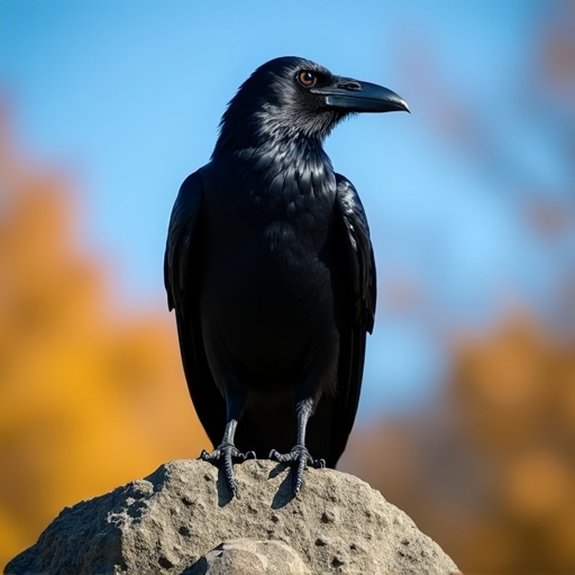The Raven in Mythology Around the World
The raven’s piercing call has echoed through humanity’s oldest stories, marking moments when mortals touch the divine. This black-winged messenger appears at civilization’s most vital junctures—from Mesopotamian floods to Norse battlefields to Pacific Northwest creation myths. It’s witnessed the birth of light and carried souls between worlds. Yet scholars can’t agree why this particular bird, among thousands of species, became mythology’s most enigmatic guide across cultures that never met.
Introduction

Throughout countless civilizations, the raven has soared through mythology as one of humanity’s most enigmatic symbols. This black-feathered bird has captured imaginations across continents, appearing in sacred texts, oral traditions, and ancient artwork. From Nordic sagas to Native American creation stories, ravens’ve served as messengers between worlds, tricksters who’ve shaped reality, and harbingers of both doom and wisdom.
The raven’s intelligence and adaptability have made it a powerful metaphor for transformation and knowledge. Its distinctive caw and dark plumage’ve inspired countless interpretations—some cultures see death’s companion, while others recognize a divine creator. This exploration examines how different societies’ve woven the raven into their spiritual tapestries, revealing universal themes that transcend geographical boundaries and historical periods.
Mesopotamian Flood Story Messenger
Among the earliest recorded appearances of the raven in mythology emerges from ancient Mesopotamia’s flood narratives, where the bird plays a pivotal role in humanity’s survival. In the Epic of Gilgamesh, dating to approximately 2100 BCE, Utnapishtim releases a raven after the great deluge subsides. Unlike the dove and swallow that return to the ark, the raven doesn’t come back—it’s found food and dry land.
This messenger role demonstrates the raven’s intelligence and adaptability, traits the Mesopotamians clearly observed. The bird’s failure to return signals safety, marking the flood’s end and earth’s renewal. This narrative predates and likely influenced later flood stories, including the biblical account of Noah. The raven’s appearance establishes its mythological significance as a boundary-crosser between destruction and rebirth, death and life.
Notable Cases or Sightings

While ravens have appeared in countless mythological texts across cultures, several specific encounters stand out for their significant impact on religious and literary traditions. Odin’s ravens, Huginn and Muninn, flew across the Nine Domains daily, bringing the Norse god essential intelligence about mortal affairs. In Welsh mythology, Bran the Blessed‘s name literally meant “raven,” and his severed head protected Britain from invasion.
The Tower of London’s ravens represent Britain’s most enduring raven tradition—legend states the kingdom will fall if they ever leave. Apollo’s raven messenger turned black after reporting Coronis’s infidelity, establishing the bird’s dark plumage in Greek myth. Native American tribes documented Raven stealing the sun to bring light to humanity, while Irish warriors followed the Morrígan’s raven form into battle.
Common Theories or Explanations
These widespread mythological appearances have prompted scholars to examine why ravens hold such universal significance across unconnected cultures. Anthropologists suggest the raven’s intelligence and problem-solving abilities naturally impressed ancient peoples, who’d observe these birds using tools and demonstrating complex social behaviors. The bird’s distinctive black plumage and harsh call made it memorable and easily distinguishable from other species.
Carl Jung’s followers propose ravens represent humanity’s shadow self—the darker aspects of consciousness that cultures must acknowledge. Others point to practical explanations: ravens’ presence at battlefields and their scavenging nature linked them to death and transformation. Their ability to mimic human speech likely enhanced their mystical reputation. Some researchers believe the raven’s adaptability to diverse environments explains why it’s featured in Arctic, temperate, and desert mythologies alike.
Frequently Asked Questions
What’s the Difference Between Ravens and Crows in Mythological Symbolism?
Ravens typically symbolize death, wisdom, and prophecy in mythology, while crows represent trickery, transformation, and messenger roles. Ravens appear more prominent in Norse and Celtic tales, whereas crows feature heavily in Native American stories.
How Do Modern Indigenous Communities View Traditional Raven Stories Today?
Modern indigenous communities preserve raven stories as living traditions that connect them to ancestral wisdom. They’re teaching these narratives to younger generations while adapting meanings for contemporary contexts, viewing ravens as cultural bridges between past and present.
Are There Any Cultures Where Ravens Represent Purely Positive Omens?
Yes, Pacific Northwest indigenous cultures like the Tlingit and Haida view ravens as purely positive figures. They’re celebrated as clever creators who brought light to humanity, representing wisdom, transformation, and beneficial trickster energy.
What Role Do Ravens Play in Contemporary Fantasy Literature and Media?
Ravens serve as mystical messengers, shapeshifters, and wise companions in modern fantasy. They’re featured prominently in works like Game of Thrones, where they carry messages, and often embody dark magic, prophecy, and ancient knowledge.
How Have Raven Myths Influenced Modern Spiritual or Neo-Pagan Practices?
Modern spiritual and neo-pagan practitioners’ve adopted ravens as symbols of wisdom, transformation, and divine communication. They incorporate raven imagery in rituals, meditation, and divination practices, drawing from Norse, Celtic, and Native American traditions.


